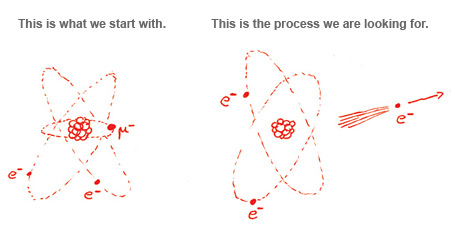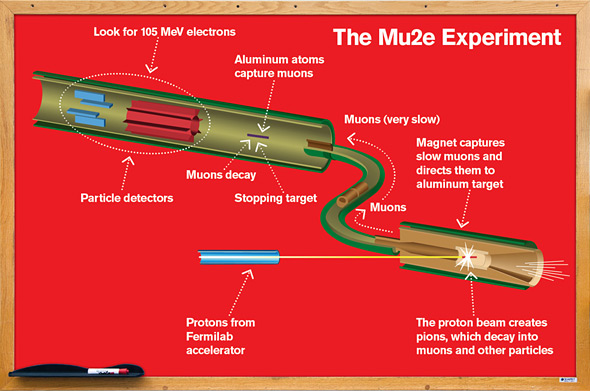The muon guys: On the hunt for new physics
By Andrea Mustain
Photography by Reidar Hahn, Fermilab
 |
| From left: Jim Miller, Ron Ray, and Robert Bernstein think the Mu2e experiment may answer one of the fundamental riddles of particle physics. |
Amid the sprawl of mysterious equipment in a workroom at Fermi National Accelerator Laboratory, Gueorgui Velev and Alexander Makarov leaned over an elegant metal box the size of a single file cabinet. Suffused by a warm halo of late-afternoon sunlight, the two men, a physicist and an engineer, had the look of modern-day priests of industry gently handling a beloved reliquary.
Velev lifted the box top, revealing a thin slice of dark-gray ferrite—a ceramic compound used in powerful magnets. Although the ferrite was wired up like an intensive-care patient, for the moment it felt cool and deliciously smooth to the touch.
Velev and Makarov have been testing ferrites like this one for almost a year now, sending powerful currents through the compound, pushing the material to its limits. Far from being a relic of something dead, the ferrite is a symbol of resurrection for an experiment that could star in its own soap opera. Attempts to carry out this experiment have died two deaths on two continents over the course of two decades.
Velev and Makarov, along with a host of collaborators, are once again bringing it to life.
The experiment's newest name, in its incarnation at Fermilab, is Mu2e (pronounced Mew to E), which stands for muon-to-electron conversion; and it is a testament to the strength of the science behind this experiment that physicists are still fighting to do it. Scientists plan to break ground at Fermilab in Batavia, Illinois, in 2013 and begin taking data four years later.
The experiment will search for a phenomenon so incredibly rare that, according to the Standard Model of physics, humans could never build a machine sensitive enough to actually see it. Which is exactly why scientists want to build this experiment. Mu2e is on the hunt for new physics.
Specifically, Mu2e is trying to catch a glimpse of one kind of particle turning into another. The experiment will look for signs of a muon—which is basically an electron's fatter cousin—converting, in a Cinderella-like transformation, into its more slender and well-known relative.
If a muon does undergo this transformation, the signs will be unmistakable. This fact alone sets Mu2e apart from many other particle physics experiments, where scientists must sort through a huge amount of "background" data that bury the sought-after results in a torrent of distractions. Finding the result you're looking for can be like picking out a whisper amidst the cacophony of Times Square. In Mu2e, the signal will blare out from the background like a siren.
Choreographing an invisible dance
To pick up this signal, physicists must build a system of jaw-dropping precision and complexity that is capable of producing 500 million billion muons per year. In a slow-motion, subatomic ballet, it must gently capture these muons within the orbits of aluminum atoms, which will provide the staging ground for the predicted transfiguration. If the Large Hadron Collider is a high-energy particle mosh pit, Mu2e is a delicate and sophisticated pas de deux. Orchestrating such minute choreography requires the combined efforts of more than 100 scientists at universities and laboratories around the globe.
Even humanity's boldest endeavors must endure one painful fact of life: meetings. Surely the Romans held meetings before they built their aqueducts, and Ernest Shackleton must have met with his crews before setting out on his famed expeditions to Antarctica.
To plan their own undertaking, Mu2e collaborators gather every Thursday in a conference room on the 12th floor of Fermilab's Wilson Hall.
On a bright morning last February, physicists clad in what seems to be the experiment's unofficial uniform (subdued sweaters over neat button-downs, jeans, a preponderance of suspenders) drifted in, carrying laptops and clutching coffee cups. Mu2e co-spokesperson Robert Bernstein was already set up at the conference table, laptop open, hurling curses at the LCD projector.
"I am pushing the right button, right? Why isn't this working?!" he said, waving a remote control toward the ceiling. "I am pushing the right button, right?"
Somebody crawled under the conference table to fiddle with cables, and was soon joined by two more physicists.
"Wait, it just reacted!" said another physicist, peering at the uncooperative machine.
"This is how all meetings begin," said Ron Ray, the Mu2e project manager, from his post near the front of the room.
"We always think we're going to start on time, and then we have these technical difficulties," said Jim Miller, a professor at Boston University and Mu2e's other co-spokesperson. "And we think we're going to mount this complicated experiment."
He was kidding. Mostly.
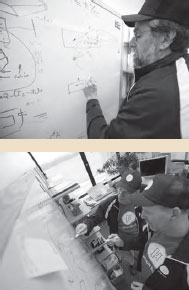 |
The men behind the machine
Bernstein, Ray, and Miller are the three people most intimately involved with Mu2e's progress.
Ron Ray is the details guy—the one who keeps tabs on the ferrite, along with all the other pieces of the experiment that are in various stages of development at Fermilab and collaborating institutions. As the project manager, it's his job to make sure Mu2e passes reviews, stays on budget, and doesn't blow deadlines.
It's a difficult position with a great deal of responsibility, but one to which Ray is well suited—even though he says physics was always Plan B. The Los Angeles Dodgers clock on his office wall and a photograph of the 1972 Los Angeles Lakers lineup are the only vestiges of Plan A. Until you see Ray himself.
"I wasn't a nerdy kid. Or at least if I was, I was a secretly nerdy kid," Ray says. "I did well in school, but I was more interested in sports than anything." Tall and lean, Ray still looks like he'd be right at home on the basketball court. He played through his freshman year at the University of California, Irvine, but eventually found the pull of physics irresistible. "I kept taking it and I kept liking it—partly because it was a challenge. I like to do hard things," he says.
Ray was the first person in his family to graduate from college, let alone get a PhD in particle physics. He says his interest in the subject came as a bit of a surprise to his family. "Sports, they understood. I'd play basketball in the driveway with my Dad when I was a kid. But the physics stuff, I don't think anybody understands where that came from."
Robert Bernstein's office is just down the hall. The son of a toll collector and a housewife, Bernstein, like Ray, was the first person in his family to graduate from college. But unlike Ray, he knew from a very young age that he wanted to be a physicist. "I was five years old, and I said to my mother, Why don't clocks run backwards?' I didn't understand why the universe didn't run backwards in time. And my mother didn't know, and I said to her, Well, who knows about that?' And she said, I think physicists know about that.' And I said, OK, that's what I'm going to do when I grow up.'"
Such cerebral ambition can make life lonely in high school. Bernstein says it wasn't until he was an undergrad at the Massachusetts Institute of Technology that he truly felt like he fit in. "I was the biggest nerd that ever existed. And I still am," he adds. He memorized pi to a thousand digits on a bet one weekend, and sang it to Liszt's "Hungarian Rhapsody Number Four." He was the president of the science fiction club. "Talk about nerds!" he says. "I got to meet all these cool guys like Theodore Sturgeon and Arthur C. Clarke."
While Bernstein talks, he's rarely far from the enormous whiteboard that covers one office wall. "I like it. It's huge. I can't live without it," he says. He regularly leaps out of his chair to scribble equations and diagrams.
Jim Miller, stationed a few doors up from Bernstein, could be Mu2e's television news presenter. He has the sonorous voice and discreet bearing of a particle-physics Peter Jennings, with a mischievous chuckle that peppers his conversation. Bespectacled, with graying hair, Miller looks every bit the physics professor—which he is, and has been for more than three decades at Boston University. If there is ever a question in your mind about particle physics, Miller can explain the answer.
As a kid growing up in Cleveland, Ohio, Miller says he was like a lot of other science geeks, tinkering away in the garage on motors and electrical things, building radio sets. "When I was very young I wanted to understand things, how they worked," he says. "Back then I was just struggling to understand things that were already understood," he adds, laughing. "But now I'm in the lucky position of being among a group of scientists who may be the first to discover something new about the universe."
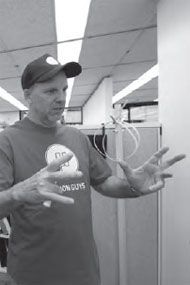 |
The family rebel
Physicists have been looking for muon-to-electron conversion for decades, almost since the muon's unexpected discovery in 1936. André de Gouvêa, a theorist at Northwestern University, says that since the muon acts like a massive electron, physicists expected it to behave a certain way. They thought it would break down into a more stable electron and jettison its extra mass in the form of energy. "But they didn't see this happen," de Gouvêa says, "so that was a big puzzle."
In fact, the muon seemed to be following some mysterious new rule, which prevented it from transforming directly into a single electron. This rule became known as flavor conservation, and was eventually adopted into the Standard Model of particles and their interactions. To understand the concept of flavor conservation, one must first understand particle flavor, and that requires a closer look at the muon's extended family.
The muon belongs to a class of particles called charged leptons. There are three charged leptons—electrons, muons, and taus, all with a negative electric charge, each heavier and more rare than the last. The muon is about 200 times more massive than the electron; the tau is a whopping 3000 times heavier than the electron. At the Charged Lepton family reunion, the electron would be the Hollywood starlet (she's skinny, she's famous), the muon would be the more generously built Goth girl, and the tau would be the full-figured opera singer. Each has her own unique qualities, and thus, her own particular flavor.
So why are muon and tau so rare, when their popular cousin seems to be everywhere? It turns out that muon and tau aren't stable. In the particle world, this means they live only a short time before they decay into lighter particles. In contrast, their slim cousin electron, through some pact with the devil, lives forever.
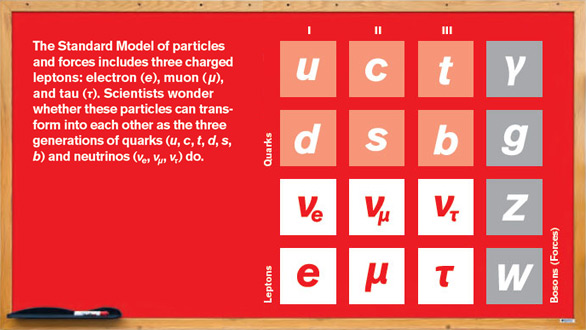 |
| Click image for larger version |
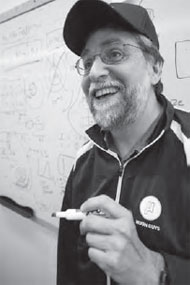 |
Flouting the flavor rule
Scientists have observed that particles, like many humans, yearn for stability. So it would make sense that chubby muon would, presto!—shed its extra heft and morph directly into svelte, immortal electron.
In fact, muons do typically decay into electrons that are accompanied by neutrinos—the aloof particles that rarely interact with anything. However, this is not flavor violation; only the direct conversion of a muon to a single electron, with the emittance of nothing else but energy, qualifies, and this has never been seen.
De Gouvêa says the law of flavor conservation "seems to be a fundamental symmetry of nature, and we want to find out why—in particular, because it is a very ad hoc one. It wasn't necessary for the world to exist. It was just something that happened."
Physicists have come to the conclusion that the Standard Model, with its ad-hoc flavor conservation policy, does, in fact, allow muons to convert directly to electrons—but only if this happens so rarely that nobody would ever be able to observe it.
However, theories that lie outside the Standard Model, such as supersymmetry, suggest that breaches of this policy—called flavor violation—do happen far more often than the model allows. That's why physicists believe there is a revolution afoot. If they're right, observing the muon-to-electron transformation should be well within the reach of Mu2e's particle detectors. It would be "unmistakable evidence of physics beyond the Standard Model," Miller says.
 |
| When a muon is trapped in an orbit around the nucleus of an aluminum atom (see diagram near top of page), it can decay in several different ways. The Mu2e experiment will look for the extremely rare process in which the muon converts directly to an electron (left). The observation of this process, predicted by new theories such as supersymmetry, would indicate the presence of a new particle or force. The energy of the single electron emerging from the atom would be exactly 105 million electronvolts, making it easy to see against a noisy background of more common events. Two of those possible background events are shown here as well. Most of the time a muon decays into a set of three particles: an electron, a neutrino and an antineutrino (center). In this case, the electron will have much less energy than 105 MeV; hence this event is easy to reject as background. But sometimes the electron gets an extra kick of energy from the nucleus (right). Since particle detectors are unable to see neutrinos and antineutrinos, the decay could resemble the signal scientists are looking for. If the neutrino and antineutrino happen to have little energy, the electron could even end up with an energy close to 105 MeV, making this decay more difficult to distinguish from the soughtafter signal. |
| Click image for larger version |
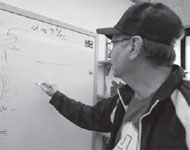 |
The experiment that would not die
Recent discoveries make the case for flavor violation within the charged lepton family even more compelling. Physicists have found that neutrinos— leptons without electric charge—are notorious flavor violators. So far, though, experiments looking for charged lepton flavor violation have come up empty handed. Many physicists believe the technology just hasn't been good enough.
Mu2e will be about 10,000 times more powerful than the last experiment to look for muon-to-electron conversion in a similar way, SINDRUM II at Switzerland's Paul Scherrer Institute, which finished taking data in the year 2000.
It will have a sensitivity of 10-17, a fancy way of saying that if only one in 100 million billion muons transforms into an electron, Mu2e will see it. The experiment is able to reach such limits because of advances that had their genesis back in the 1980s, behind the Iron Curtain. In a way, Mu2e was born in the Soviet Union.
In February 1989, the Soviet Journal of Nuclear Physics ran a letter to the editor from physicists Vladimir Lobashev and Rashid Djilkibaev, in which they proposed an experiment that would perform the most thorough search yet for muon-to-electron flavor violation.
Lobashev had dreamed up some creative changes to existing technology, and in 1992, the experiment, named MELC, was given the green light and work began at the Moscow Meson Factory. But by 1995, Djilkibaev says, the experiment shut down, felled by the political and economic crisis gripping a faltering empire.
At around the same time, a physicist and flavor-violation specialist named William Molzon, based at the University of California, Irvine, started looking around for a new experiment to work on. Molzon says he'd heard about Lobashev's work and was intrigued enough to go to Russia to meet with him. "I actually visited the accelerator," says Molzon. "It was sort of like a ghost town."
By 1997, Molzon and his collaborators had a proposal to revive a MELC-based experiment at Brookhaven National Laboratory on Long Island. Their experiment had a new design, a new kind of detector, and a new name: MECO.
R&D got under way in 2001, and MECO was on its way to becoming the most sensitive muon-to-electron conversion experiment ever built. But in 2005, despite glowing reviews from experts, the funding agency pulled the plug. "We were quite far along," Molzon says. "That was a very sad story."
One of Molzon's collaborators on MECO was Jim Miller. As a self-proclaimed "muon guy," he'd joined the experiment a few years before it was killed. "I thought, well, there go two or three years down the tubes. And for some people it was many more years," he says.
But those years weren't a complete loss, because Mu2e is building on the effort put into MECO and its predecessors, Miller says. "Those guys put a lot of design work and thought into this," he says, "so they didn't waste their lives, even though some of them may not be around to see the results."
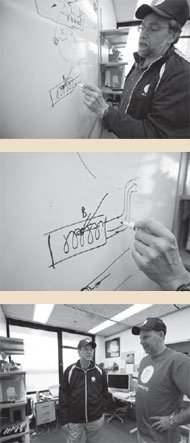 |
The moment they're all waiting for
The magic result all these scientists are after—the one they have been chasing for so many decades—is one simple number: 105.
The Mu2e experiment will use an intense proton beam to produce a huge number of muons. The slowest muons are then captured by powerful electromagnets and pushed, ever so gently, against a sheet of aluminum only about 10 times thicker than the foil in your kitchen cabinet. The negatively charged muons find the positively charged aluminum nuclei irresistible; they are drawn inexorably inward, until the two bodies, muon and nucleus, nestle together in a cozy orbit.
If the muon does perform its nifty transformation into its much smaller electron cousin, physicists know that this electron will wrest free from the aluminum atom's embrace, and shoot into Mu2e's particle detector with an energy that is unmistakable: 105 million electronvolts.
This number in the detector would be solid evidence that the muon has transformed, the tell-tale glass slipper the electron leaves behind. More impressively, this Cinderella would be wearing size 17 shoes; if the slipper is there, you'll see it. And the fairy godmother responsible for the metamorphosis would be something brand new—a new particle, a new force, a new something that would change our most basic understanding of how the universe works.
For now, Ray, Miller, and Bernstein spend their days focusing on the temporal matters at hand—running computer simulations, battling the LCD projector, keeping track of tests that will determine which type of ferrite is best for the specialized electromagnet that will keep Mu2e's proton beam pristine.
Bernstein seems undaunted by the rather ordinary nature of the day-today operations required to bring this massive experiment to fruition.
"I'll be doing this for a decade," Bernstein says, "then figure out what to do after that. I'm not gonna retire; they're gonna pull me out of here feet first.
"Why would I leave here?" he says, grinning. "This is the greatest place in the world."
Click here to download the pdf version of this article.



